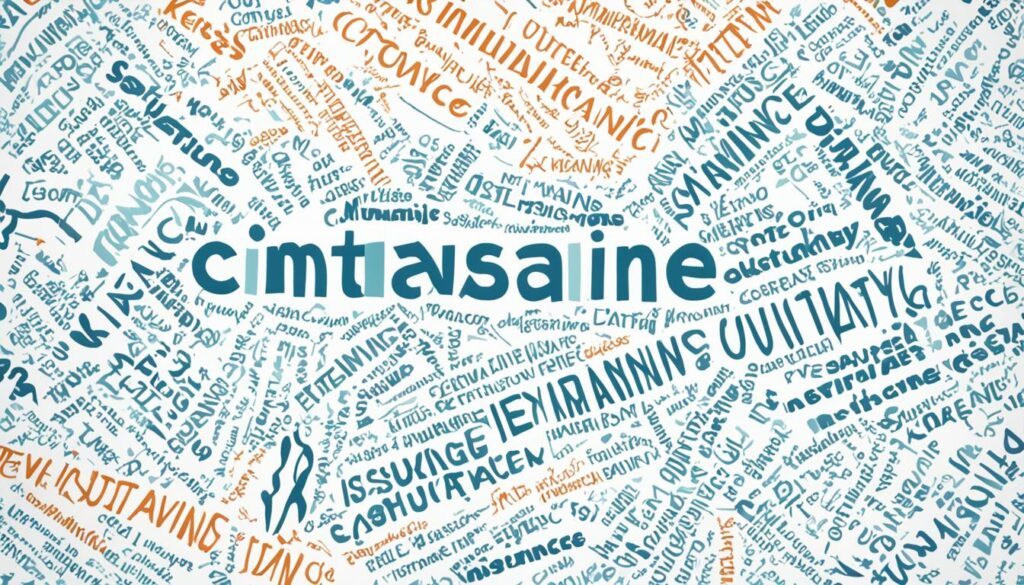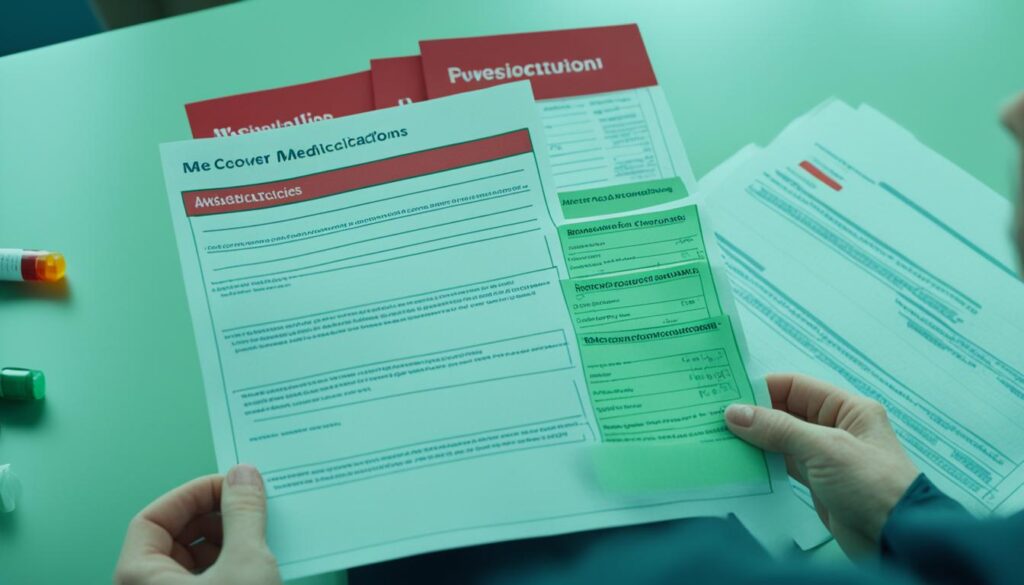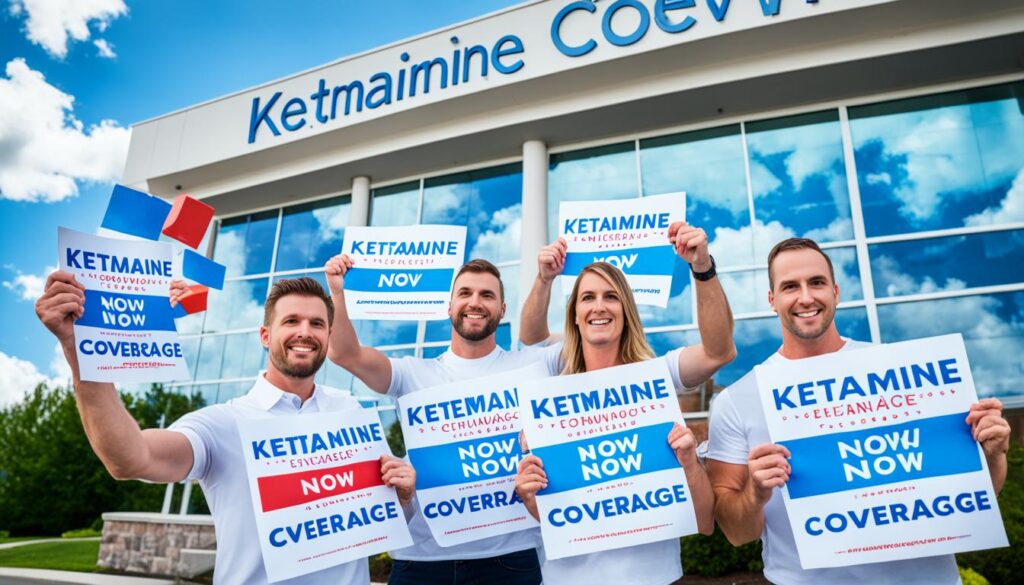Discover how to get ketamine infusions covered by insurance, navigate eligibility criteria, and explore affordable options for depression treatment in the US.
Ketamine infusion therapy is a new hope for people with severe depression, anxiety, and PTSD. But, many can’t get this treatment because of limited insurance coverage. Insurance sees ketamine as “off-label,” making it hard to get paid for.
The FDA approved ketamine in 1970 for anesthesia. Now, it’s known to help with mood disorders. Studies show ketamine infusions work well for mental health issues. But, insurance companies still see it as experimental, making it hard for patients to get coverage.
Spravato, a ketamine nasal spray, is easier to get covered by insurance for depression. But, getting coverage for IV, IM, and sublingual/oral ketamine is still tough. Yet, things are slowly getting better. Some insurers cover ketamine therapy in certain cases. Laws like the Mental Health Parity Act also aim to make these treatments more accessible.
This guide helps you understand how to get ketamine infusions covered by insurance. It covers how to deal with policies, get coverage, and look into other ways to pay. By knowing how insurance works and what to do, patients and doctors can make this treatment available to those who need it.
Key Takeaways
- Ketamine infusion therapy is a highly effective treatment for severe mental health conditions, but insurance coverage remains limited.
- Off-label use and experimental treatment classifications pose challenges in obtaining insurance reimbursement for ketamine infusions.
- Spravato, an FDA-approved esketamine treatment, has seen more success in securing insurance coverage compared to generic ketamine.
- Gradual progress in insurance coverage for IV, IM, and sublingual/oral ketamine has been observed in recent years.
- Patients and providers can work together to advocate for coverage, navigate policies, and explore alternative financing options for ketamine treatment.
Understanding Ketamine Infusion Therapy
Ketamine infusion therapy is a new way to help people with severe mental health issues like depression, anxiety, and PTSD. It uses ketamine, a drug known for its anesthetic effects, in a controlled setting. This method is being studied as a potential treatment.
What is Ketamine Infusion Therapy?
Ketamine infusion therapy gives ketamine through an IV in several sessions. Experts in ketamine clinics do this. Each session lasts about 40 minutes to an hour, during which the patient gets a specific dose of ketamine. They are watched for any side effects.
Ketamine was approved by the FDA in 1970 for anesthesia. But, using it for mental health issues is not its original purpose. Still, research and clinical trials show it might help with depression, anxiety, and PTSD.
How Ketamine Works for Mental Health Conditions
Ketamine works on the brain’s glutamate system to help mental health disorders. Unlike usual antidepressants, it doesn’t focus on serotonin or norepinephrine. Instead, it affects the NMDA receptor in the glutamate system.
This action changes how neurons talk to each other, helping fix broken neural paths. This is why ketamine can quickly ease symptoms of depression, anxiety, and PTSD.
Many studies show ketamine infusion therapy is effective for mental health issues. For those with depression that doesn’t respond to other treatments, ketamine can make a big difference. It also helps with anxiety and PTSD by changing how the brain remembers traumatic events.
As research goes on, ketamine infusion therapy is seen as a new hope for those with serious mental health problems. It targets the glutamate system and changes neural connections quickly. This makes it a valuable option for those who haven’t found relief with traditional treatments.
The Current State of Insurance Coverage for Ketamine Infusions
Ketamine infusion therapy is showing promise for treating mental health and chronic pain. But, getting insurance to cover it is hard. Many patients can’t afford it because most insurance sees it as off-label or experimental.

Challenges in Obtaining Insurance Reimbursement
Insurance won’t pay for ketamine therapy because it’s not FDA-approved for depression. Companies say it’s too new and not proven. This means many patients must pay themselves, which is very expensive.
Getting insurance to pay is also hard because treatment plans vary. Each patient gets a different dose and schedule. This makes it hard for insurance to set clear rules for coverage.
Off-Label Use and Experimental Treatment Classification
Ketamine is used for more than just anesthesia, even though it’s not FDA-approved for those uses. This makes insurance companies hesitant to pay. But, doctors can legally use it if they think it’s best for their patients.
There’s hope, though. Some insurance companies are starting to cover ketamine for certain conditions. For example, they might pay for it if you have Complex Regional Pain Syndrome (CRPS) or Reflex Sympathetic Dystrophy (RSD).
| Condition | Typical Dosage Range | Infusion Time | Treatment Course |
|---|---|---|---|
| Depression | 0.5-1.0mg/kg | 40 minutes | 3-5 infusions over 4-5 weeks |
| Chronic Pain (e.g., CRPS, RSD) | 0.5-1.0mg/kg | 40 minutes | 3-5 infusions over 4-5 weeks |
As research grows, we hope insurance will cover ketamine more. Until then, patients and doctors must find ways to pay for it. This could mean looking at other financing options to get this therapy.
Navigating Insurance Policies for Ketamine Treatment
Looking for ketamine insurance coverage can be tough and often frustrating. Mental health is now more recognized, but insurance for treatments like ketamine infusion therapy is still catching up. Many insurances cover usual treatments like therapy and approved meds. But, they often don’t keep up with new and alternative treatments like ketamine.
Insurance policies and coverage levels differ a lot between providers. Some ketamine clinics are finding new ways to work with insurances. They have in-network specialists handle billing for visits, evaluations, and therapy. Patients pay the rest out-of-pocket. Each medical specialty has its own billing codes.
To get the best chance at ketamine insurance coverage, clinic staff should spend time researching insurance companies they work with. A skilled billing specialist can greatly help by understanding complex reimbursement rules.
| Insurance Provider | Potential Coverage for Ketamine Therapy |
|---|---|
| Aetna | Partners with MPH for in-network coverage, reducing treatment costs by up to 50% |
| Blue Cross Blue Shield (BCBS) | Collaborates with MPH for in-network coverage, making therapy more affordable |
| Out-of-Network Benefits | Potential for partial reimbursement, depending on the terms of the insurance plan |
When looking at ketamine insurance options, it’s smart to carefully read through insurance policies. Look for details on experimental treatments, mental health services, and out-of-network benefits. This can help get the most coverage for ketamine therapy. Keeping detailed records of talks with insurance companies and treatment documents is also key. This helps with appealing denied claims if needed.
By getting to know how to navigate ketamine insurance policies and working with experts, patients and providers can better secure coverage for this promising treatment.
Case-by-Case Coverage: What You Need to Know
More insurance companies are now covering ketamine infusion therapy for mental health issues. This decision is based on each patient’s unique situation. They look at many factors to decide if ketamine treatment will be covered.

Factors Influencing Insurance Decisions
Insurance companies look at several things when deciding on ketamine coverage:
- The patient’s specific diagnosis and how severe it is
- What treatments the patient has tried before and how they worked
- Why the doctor thinks ketamine infusion therapy is needed
- Proof from mental health experts
Insurance is more likely to cover for patients with depression or other mental health issues that haven’t gotten better with usual treatments. Showing a clear need for ketamine through detailed records can help get coverage.
Documenting Medical Necessity
To get insurance to cover ketamine, you need to show why it’s needed. This includes:
- Records of all treatments tried before and how they worked
- Notes from mental health professionals
- Letters explaining why ketamine is the best treatment option
- Proof that other treatments didn’t work
Working with doctors, therapists, and other health experts to gather these documents helps a lot. A strong case for why ketamine is needed can make it more likely to get insurance approval.
| Documentation | Purpose |
|---|---|
| Treatment records | Show what therapies were tried before and their results |
| Progress notes | Give insights from mental health experts |
| Letters of medical necessity | Explain why ketamine is the best choice |
| Evidence of treatment-resistant conditions | Point out the need for new treatments like ketamine |
Knowing what affects insurance decisions and focusing on proving the need for ketamine can help patients and doctors. As more insurers see the benefits of this treatment, getting coverage on a case-by-case basis might get easier. This could lead to more people getting access to ketamine therapy.
How to Get Ketamine Infusions Covered by Insurance
Ketamine infusion therapy is promising for treating depression, chronic pain, and mental health issues. But, getting insurance to cover it is hard. Patients can work to get coverage by advocating and understanding insurance rules.
Steps to Advocate for Coverage
Start by talking to your insurance about ketamine therapy and its benefits. It’s key to show why you need it for your health. Gather evidence like:
- Records of treatments that didn’t work
- Medical records showing how your condition affects your life
- Studies proving ketamine infusions help your condition
Gathering Supporting Documentation
Getting the right documents is crucial for insurance approval. Work with your doctor to make a detailed treatment plan. This should include:
- How many infusions you’ll need and how often
- What results you expect and how long treatment will last
- Any follow-up care you’ll need
Also, collect any medical history that shows you need ketamine. This could be records of past treatments and their results.
Appealing Insurance Denials
If your insurance says no to ketamine therapy, you can appeal. You’ll need to send more documents and a detailed appeal letter. In your appeal, make sure to:
- Explain how your condition affects your life
- Detail the treatments you’ve tried before
- Add proof from doctors and research
Many ketamine clinics know how to deal with insurance. They can help with the appeal process and what documents you need. With the right support and persistence, you might get insurance to cover ketamine infusions.
| Treatment | Average Cost per Infusion | Insurance Coverage |
|---|---|---|
| Ketamine for Depression | $400 – $800 | Limited; may cover evaluation or consultation fees |
| Ketamine for Chronic Pain | $800 – $2,000 | Rarely covered; considered experimental |
| Intranasal Esketamine (Spravato) | $590 – $885 per treatment session | Covered by most insurances after prior authorization |
Partial Coverage Options for Ketamine Therapy
Full insurance coverage for ketamine infusion therapy is rare. Yet, some insurance plans offer partial coverage for related services. These options can help reduce the cost of ketamine treatment.

Related Services That May Be Covered
Even if ketamine infusions aren’t covered, insurance might pay for related services. These services are key to the treatment process. They include:
- Initial consultations with mental health professionals
- Psychiatric evaluations to determine eligibility for ketamine therapy
- Follow-up visits to monitor progress and adjust treatment plans
- Medication management and monitoring
Talk to your ketamine provider about which services might be covered. By listing these services separately, you could get partial payment for your treatment.
Utilizing Superbills for Reimbursement
A superbill is a detailed receipt that lists medical services separately. Many ketamine clinics give patients superbills for insurance claims. To get partial payment, send the superbill to your insurance company. They’ll check if you’re eligible for coverage.
Getting reimbursement can depend on your insurance plan. But, it’s worth trying for those looking to lower ketamine therapy costs. Work with your ketamine provider to get the right paperwork and help with submitting the superbill.
| Insurance Type | Potential Partial Coverage |
|---|---|
| Private Insurance | Related services such as consultations, evaluations, and follow-up visits |
| Medicare | Limited coverage for FDA-approved Spravato (esketamine) treatment |
| Medicaid | Coverage varies by state; some may offer partial reimbursement for related services |
| VA Insurance | Some VA facilities offer ketamine therapy for veterans, which may be covered |
Looking into partial coverage and using superbills can lower the cost of ketamine therapy. As more insurance plans see the benefits of ketamine, coverage might get better. This could make the treatment more available to those who need it.
Spravato: FDA-Approved Esketamine Treatment
In 2019, the FDA approved Spravato esketamine treatment. It’s a nasal spray made by Janssen Pharmaceuticals for adults with depression that hasn’t gotten better with other treatments. Spravato comes from ketamine and is stronger. It’s now approved as a nasal spray for this tough type of depression.

Patients with major depressive disorder need to have tried two antidepressants before getting Spravato. The treatment was tested in three short trials. One trial showed it helped with depression in just two days.
Esketamine therapy means taking nasal spray three times, five minutes apart, while being watched. This is done to make sure the patient is okay. At first, patients take it twice a week for a month, then less often if it helps.
Side effects seen in trials include:
- Dissociation
- Dizziness
- Nausea
- Sedation
- Vertigo
- Anxiety
Spravato must be given in a doctor’s office because of risks like sedation and misuse. People with high blood pressure or certain heart problems could have more serious side effects.
Esketamine can help with depression fast, unlike traditional antidepressants. It also helps reduce suicidal thoughts. For those who don’t respond to usual treatments, esketamine works well.
Thanks to FDA approval, insurance covers Spravato more than generic ketamine. Most big insurance companies pay for it. But, there are rules and limits for providers and patients to follow.
Ketamine Coverage for Veterans and Military Personnel
Veterans and military personnel often face mental health challenges. About 14%-16% of those from Iraq and Afghanistan wars have PTSD or depression. The Department of Veterans Affairs (VA) sees ketamine infusion therapy as a possible solution for treatment-resistant depression and PTSD. Now, some VA facilities cover ketamine infusions for eligible veterans, making this treatment more available to those who have served.

VA Coverage for Ketamine Infusions
The VA is working to make ketamine-based treatments more accessible to veterans. They’ve partnered with Ketamine Wellness Centers in places like Naperville, Illinois, and Burnsville, Minnesota. This allows veterans to get FDA-approved ketamine nasal spray (SPRAVATO) at clinics across the western U.S. But, the VA is being cautious, only allowing SPRAVATO for specific cases.
To get treatment, veterans need prior authorization from the VA due to possible side effects like high blood pressure, feeling disconnected, or suicidal thoughts. Still, the VA’s efforts to cover ketamine for veterans are a big step in helping those who have served our country.
Eligibility Criteria for Veterans
Whether veterans can get VA coverage for ketamine infusion therapy depends on their diagnosis, treatment history, and condition severity. They should talk to their VA healthcare provider to see if they qualify. Some important facts show how effective ketamine therapy can be for veterans:
- 56% of veterans with suicidal thoughts saw a decrease after starting ketamine therapy
- 70% had a 50% drop in depression scores after the first phase of treatment
- 86% showed significant improvement in treatment-resistant depression with repeated ketamine infusions
| Treatment Option | Estimated VA Annual Drug Costs (per 100 Veterans) |
|---|---|
| Esketamine (SPRAVATO) | $1,157,000 – $3,729,600 |
| IV Ketamine | $1,500 |
Not only the VA but also military treatment facilities and private clinics for veterans offer ketamine infusion therapy. Veterans should look into these options to find the best treatment for them. As research continues to prove ketamine therapy’s benefits, it’s crucial that veterans get access to this potentially life-changing treatment.
Employer-Sponsored Insurance and Ketamine Coverage
Some employers are now adding ketamine infusion therapy to their health insurance plans. This move helps support the mental health of their workers. It also boosts productivity.

Companies that offer ketamine coverage know it can greatly improve mental health and job satisfaction. This treatment helps with depression, anxiety, and PTSD. It can make employees more productive and less absent.
If you’re an employee looking into ketamine therapy, check your insurance plan or talk to HR. They can tell you if it’s covered. Adding ketamine to insurance is a growing trend.
Not all employers cover ketamine yet. But, employees can push for it during insurance talks. Show how it helps the company and your health. This might convince employers to add it to their plans.
As more companies support mental health, ketamine therapy might become more common. It’s a way to help employees stay healthy and productive. Employers that offer this can create a better work environment for everyone.
The Role of Advocacy in Expanding Ketamine Insurance Coverage
The ketamine clinic industry is growing fast, with revenues hitting $3.1 billion in 2022 and expected to hit $6.9 billion by 2030. Advocacy for ketamine insurance coverage is now key. Even though 500 to 750 ketamine clinics have opened in the U.S., insurance often doesn’t cover ketamine for mental health. This means patients pay out-of-pocket for treatments that can cost $600 to $1,000 per session.
Advocacy groups are vital in making ketamine therapy more accessible by pushing for more insurance coverage. They educate policymakers, insurance companies, and the public on ketamine infusion therapy’s benefits. They also work with clinics and providers to set guidelines for safe and effective ketamine use.

Organizations Working to Improve Access
Some groups are leading the charge in pushing for more ketamine insurance coverage. The Taskforce is focusing on Complex Regional Pain Syndrome (CRPS) as a key area for ketamine treatment. They’ve applied to the Centers for Medicare and Medicaid Services (CMS) for coverage and are gathering data to support their application.
The Advocacy Consortium Clinic Consortium is a network of clinics aiming to ensure safe ketamine treatments get insurance coverage. They’re collecting data to show how effective ketamine treatments are. This data will help push for more insurance coverage for pain and mental health issues.
How Patients and Providers Can Get Involved
Patients and providers can greatly help in the fight for more ketamine insurance coverage. By sharing their stories, they can show the real benefits of expanded access to this treatment. Talking to local reps and insurance companies about supporting ketamine coverage can also make a difference.
Supporting groups that improve ketamine access can be done through donations, volunteering, or lobbying. As psychedelics like MDMA and psilocybin get FDA approval for mental health, the role of patients and providers in ketamine advocacy will be crucial in shaping mental health care’s future.
| Advocacy Initiative | Goal | Progress |
|---|---|---|
| Taskforce for CRPS Coverage | Expand insurance coverage for ketamine treatment of CRPS | Application submitted to CMS; real-world data being collected |
| Advocacy Consortium Clinic Consortium | Collect data to demonstrate efficacy of ketamine treatments | Anonymized and aggregated data being collected for retrospective analysis |
| Patient and Provider Involvement | Share stories and experiences to build support for expanded coverage | Ongoing efforts to engage with representatives and insurance companies |
Alternative Financing Options for Ketamine Treatment
If you don’t have insurance for ketamine infusion therapy, there are ways to make it more affordable. It’s key to look at each option’s terms and conditions to find the best fit for your budget.

Health Savings Accounts (HSAs) and Flexible Spending Accounts (FSAs)
Health Savings Accounts (HSAs) and Flexible Spending Accounts (FSAs) let you save pre-tax dollars for medical costs, like ketamine therapy. These accounts can cut down on the cost of treatment. Always check with your plan to see if ketamine therapy is covered.
Payment Plans and Financing Programs
Ketamine clinics often have payment plans or financing to ease the cost over time. These plans set a fixed monthly payment for a certain period. Companies like Better U work with providers like Klarna and Affirm for financing options.
When looking at payment plans, make sure to read all the details, including interest rates and fees. Looking at different options can help you find the best deal.
| Financing Option | Key Features |
|---|---|
| Health Savings Accounts (HSAs) |
|
| Flexible Spending Accounts (FSAs) |
|
| Payment Plans |
|
| Financing Programs |
|
Some groups and foundations offer grants or scholarships for those who need financial help for ketamine treatment. Looking into these can uncover more ways to cover the cost of care.
Conclusion
The way we treat mental health is changing, and ketamine infusion therapy could be a big part of that change. Even though many insurance companies don’t cover it yet, things are slowly getting better. People, doctors, and advocates are pushing for more coverage because studies show it can really help with depression.
Finding ketamine infusion therapy can be hard because of insurance issues. But, there are ways to get it, like asking for exceptions or looking into payment plans. Working with experts and advocates can make finding help easier.
As more research comes out, we’re seeing ketamine therapy’s benefits. This could mean more people can get it in the future. If we keep pushing for change, we can make sure everyone has access to good mental health care.

COMMENTS